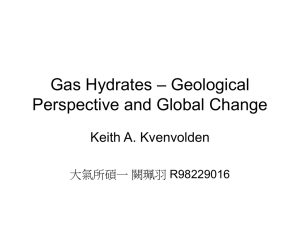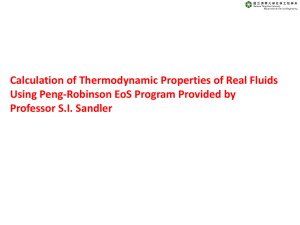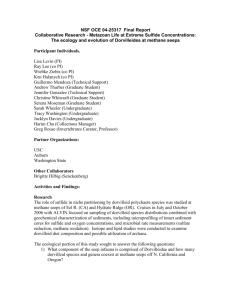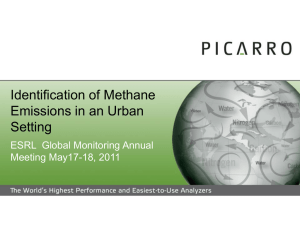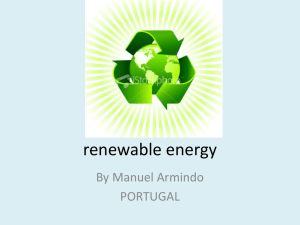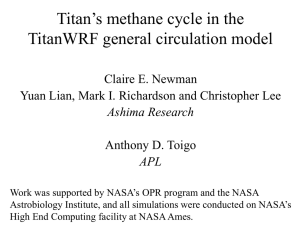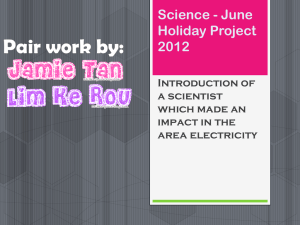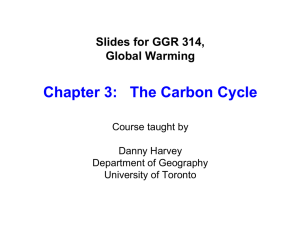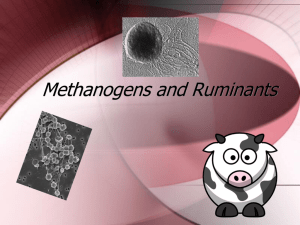Hendricks GSA 2014 From subsurface to seafloor
advertisement
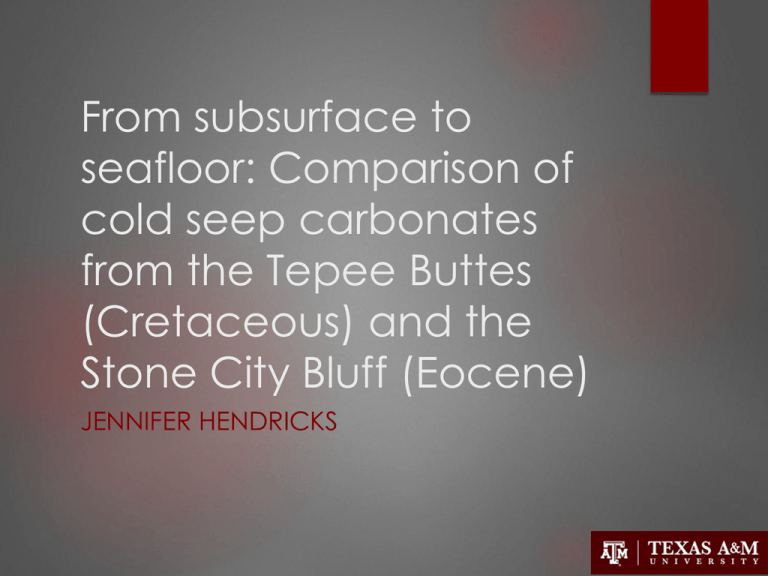
From subsurface to seafloor: Comparison of cold seep carbonates from the Tepee Buttes (Cretaceous) and the Stone City Bluff (Eocene) JENNIFER HENDRICKS Outline Research Problems Cold Seeps Tepee Buttes, Colorado Stone City Bluffs, Texas Cold Seep Formation Conclusions Problems Determine field relationships, paragenetic sequence and diagenesis of seep carbonates Trace seep carbonate porosity through time Connect and compare the surface and subsurface expressions of methane derived carbonates Identify the path of methane movement from the subsurface to the seafloor What are Cold seeps? Ocean communities formed around hydrocarbon-rich fluids seeping from seafloor Based around chemosynthetic bacteria Free living or symbiotic Unique chemistry promotes carbonate formation MacDonald Texas A&M Levin, Scripps Institute of Oceanography The Tepee Buttes Carbonate mounds located in Pierre Shale Irregular grouping Late Cretaceous methane seeps Laterally and vertically Seep activity over 10 my From Metz, 2010 Western Interior Seaway Shallow water <300 m depth From Shapiro and Fricke, 2002 Mound Shape Current mound shape is a result of weathering Forms in thin beds Interfingers with surrounding shale Carbonate formed at or near the sediment-water interface 4. Bivalve shells replaced by ferroan calcite 6. Silica Replacement Beige Facies 1. Peloids in micrite and calcite 1. Deposition of forams and bivalves 2. Formation of vugs 3. Botryoidal Calcite 3. Early sparry calcite vug 5. Ferroan Sparry Calcite Other Ferroan Calcite Stable Isotopes Tepee Buttes Boone Facies Characterization: Fabrics -14.00 -12.00 -10.00 -8.00 -6.00 -4.00 -2.00 0.00 10.00 0.00 Peloids in Micrite Peloids in Calcite δ13C (VPDB) -10.00 Botryoids Lucinid Shell Late Fabrics Inoceramid Shell Diagenetic trend -20.00 Ferroan Sparry Calcite Ferroan Calcite 2 Micrite sans Peloids Ferroan Dolomite -30.00 Dolomite Peloids in Ferroan Brown Calcite Early Fabrics δ18O (VPDB) -40.00 -50.00 Methane Pathways Seep Vent facies has been previously interpreted as containing worm tubes Methane Pathways Tubes are more likely pathways through which methane rich fluids moved through Preserves siliciclastic sediment in the tubes, suggesting fluid flow Later filled in with cement Siliciclastic sediment Methane Pathways But… we don’t see the subsurface methane pathways expressed at the Tepee Buttes Stone City Bluffs Located in Burleson County, TX on the Brazos River Also known as Whiskey Bridge Part of the Crockett formation Upper Middle Eocene Siliciclastic transgressive systems tract From Hendricks et al., 2012 Contains unusual elongate carbonate concretions From Davidoff and Yancey, 1993 Exterior Morphology Located in shale above contact with lower sandy unit Up to 70 cm long and 20 cm diameter Pinch and swell with surrounding sediment 1 cm micropipe runs through center of barrels Interior Morphology Partially healed septarian fractures 2 episodes of calcite fracture fill Micropipe is always lined with pyrite Micropipe filled with Calcite cement Pyrite Glauconite pellets Sediment Shell fragments Isotopic Analysis Methane Migration Methane moves through the subsurface in preferred pathways These are preserved as barrel concretions, with the central micropipe being the main conduit No surface or true “cold seep” carbonate seen at Stone City Subsurface Cold Seep Formation Barrel Concretions Methane Formation Subsurface Cold Seep Formation Barrel Concretions Methane Formation Cold Seep Formation Sedimentation Subsurface Organisms Barrel Concretions Methane Formation Cold Seep Formation Subsurface Organisms Barrel Concretions Methane Formation Cold Seep Formation Subsurface Organisms Barrel Concretions Methane Formation Conclusions Tepee Buttes are Cretaceous cold seeps that are the surface expression of a methane migration system Barrel Concretions from Stone City Bluff preserve subsurface pipeways for methane migration Combining these 2 features, we can formulate a comprehensive model of methane migration from the subsurface to the seafloor Barrel concretions form in the subsurface, and are the plumbing of the seep system, with the surface expression looking like the Tepee Buttes Acknowledgements Anne Raymond Michael Pope Tom Yancey Ethan Grossman Cheryl Metz Shell GSA Research Grant, 2012 AAPG James E. Hook Memorial Grant, 2012 Questions?
